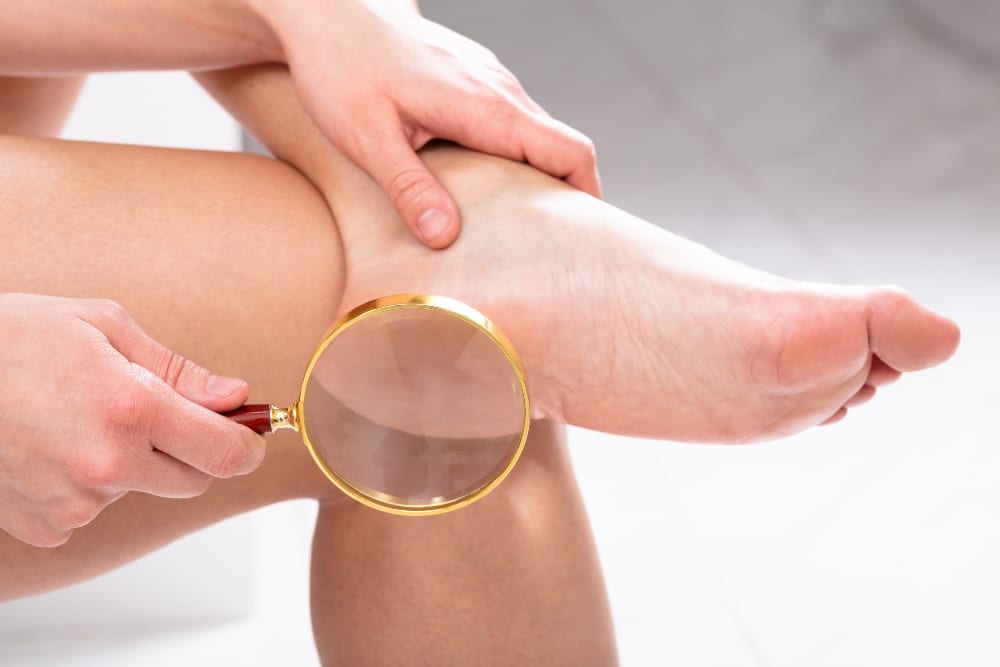Minor burns, cuts, or wounds are a normal part of life. However, if you’ve been diagnosed with diabetes, these simple injuries can be detrimental to your overall health. In fact, studies show that between 40% to 70% of all nontraumatic lower-extremity amputations are caused by diabetes.
This is why it’s critical that you exercise diabetic foot care to prevent future problems that could cause serious damage to the foot and ankle. We have compiled four essential tips for diabetic foot care that you can perform daily to lead a healthy lifestyle.

Conduct Daily Inspections
Most diabetics also suffer from a type of nerve damage known as peripheral neuropathy. It causes numbness and makes it difficult for you to feel or identify when you have blisters, sore feet, or cuts. This, coupled with the reduced blood flow, means that your feet may not get the oxygen and nutrients needed for proper healing. So, make sure your feet get the attention they deserve!
Conduct visual checks every day, even when you think everything is alright. Pay close attention to the bottom of the feet and use a mirror or ask someone else to help if you can’t get a clear view.
Here are more practical tips you should use when checking your feet;
- Set a particular time to conduct the checks so that you don’t forget.
- Check between your toes for fungus or cuts.
- Check your heels, toes, and feet for dry and cracked skin.
- Check for tenderness, increased warmth, and redness.
- Check for corns, ingrown toenails, and calluses.
- Check for scrapes, scratches, bruises, sores, and blisters on your heels, toes, and feet.
Make sure you use good lighting as you conduct visual checks to ensure you don’t miss any problems.
Keep Your Feet Moisturized
Wash your feet every day but avoid soaking them in water for a long time as this can dry out your skin. We also recommend that you use warm water and mild soaps to avoid irritating the skin and causing bruises. Make sure you also dry your feet thoroughly but instead of rubbing them, pat them gently.
After washing your feet, keep the top and bottoms of your feet moisturized by applying a thin layer of lotion. Failing to moisturize your feet causes the skin to crack, which then makes it easier for bacteria to get through. Additionally, these infections can be dangerous since your body has a hard time healing them.
Avoid moisturizing the spaces between your toes because they don’t get much oxygen. This results in the skin getting moist, breaking down, and eventually getting infected. If possible, you should use non-medicated powder on your feet before putting on socks and shoes to keep your feet dry throughout the day.

Get Shoes That Fit
Invest in a properly fitting pair of shoes. If you buy narrow shoes and have diabetic neuropathy, you may not realize when you get blisters, and this will leave you susceptible to infections. Surprisingly, studies show that over 70% of people wear ill-fitting shoes. You can’t afford to be one of them!
Keep in mind that your feet are more vulnerable to sores, and you may be putting them at risk by getting shoes that don’t fit.
Here’s a simple but effective test to check whether your shoes will fit;
- Stand on a piece of paper and trace your foot’s outline.
- Put on your shoes, stand on another piece of paper and then trace the shoe’s outline.
- Compare both tracings and ensure the shoe’s tracing is as wide as your foot and no less than 0.5 inches longer than your biggest toe.
You should also avoid walking barefoot as you may come into contact with materials that could irritate your feet.
Avoid Trimming or Cutting Corns and Calluses
If you notice that you have corn and calluses, make sure you contact us as soon as possible. Trimming or cutting them yourself could create foot sores that could potentially let in harmful bacteria, ultimately causing an infection.
We will advise you on the best and safest way to remove the corns without potentially harming your skin. If you, however, cut the corns and end up injuring yourself, seek medical advice immediately. Early treatment will prevent the formation of infections or prevent them from spreading.
Don’t Forget to Check-Up with Your Podiatrist Regularly
If you suffer from Type 2 Diabetes, there’s only so much you can do at home, which is why you should schedule regular checkups with our team. You should also remain vigilant and adopt a proactive approach so that you visit your foot doctor at the first sign of trouble. Don’t forget to stay active and follow these tips for diabetic foot care!
Schedule an appointment or consultation by giving us a call or by filling out our online contact form.
